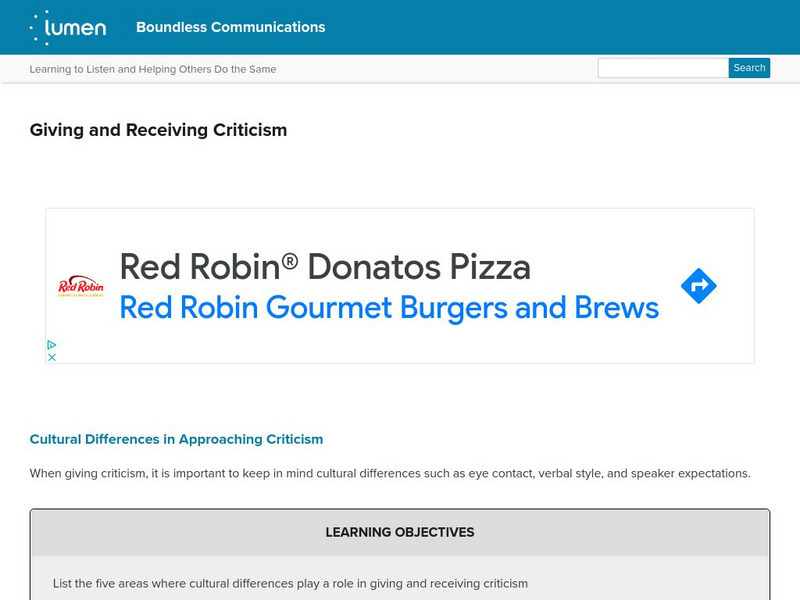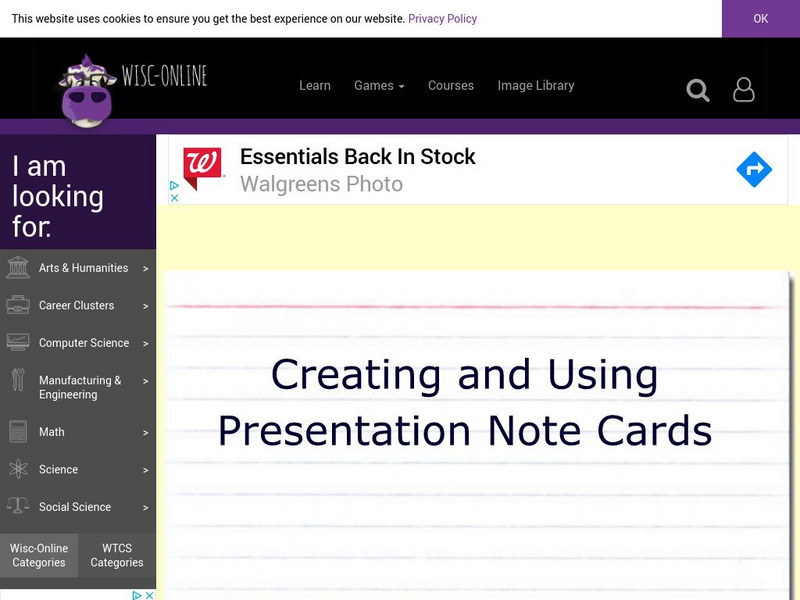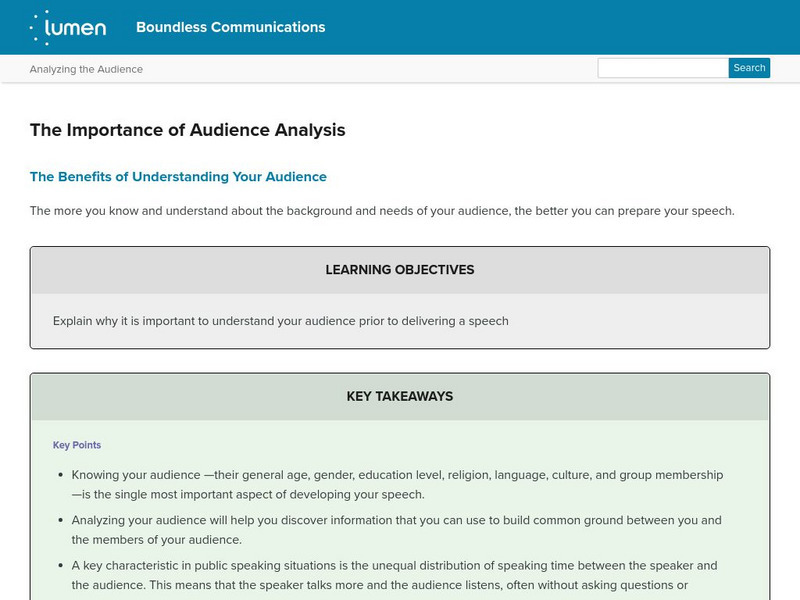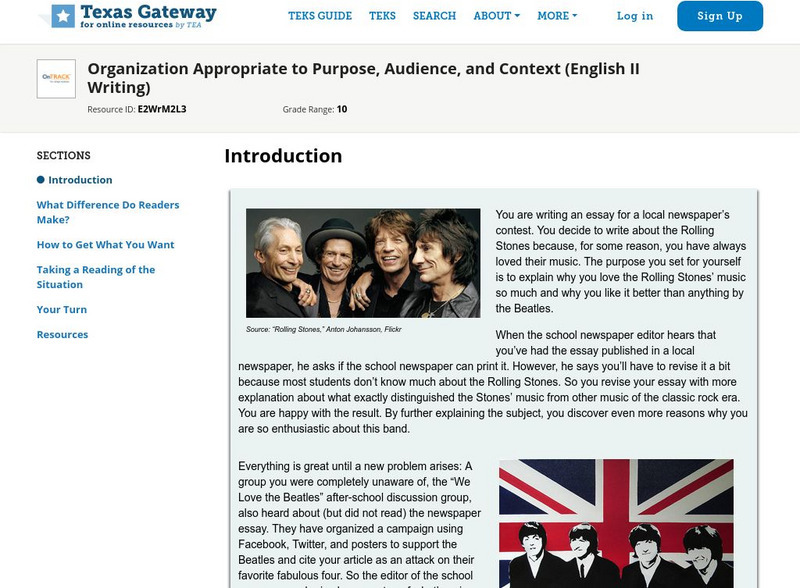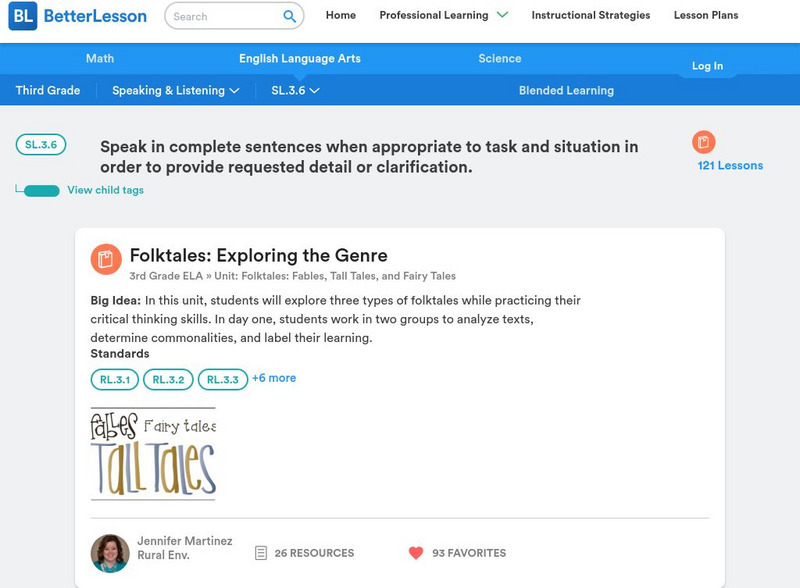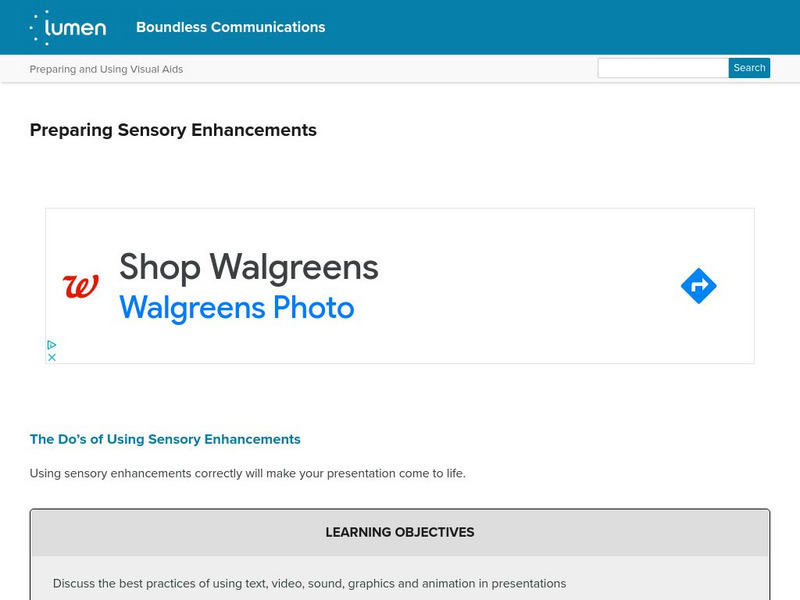Lumen Learning
Lumen: Boundless Communications: Giving and Receiving Criticism
This site provides three links on the topic of giving and receiving criticism. They are as follows: Cultural differences in approaching criticism; Be positive, specific, objective, and constructive; and techniques for accepting...
Lumen Learning
Lumen: Boundless Communications: Contextual Factors to Consider
In this Boundless Communication presentation, students will learn about contexts to consider when preparing a speech including physical, the psychology of audience, audience opinion of you and topic, and audience knowledge of the topic.
Lumen Learning
Lumen: Boundless Communications: Outlining
This website focuses on students the importance of having of outlining; it offers links to the discussion of four outlining concepts: Reasons for outlining, the Preparation outline, the Speaking outline, and the Rough Draft outline.
Lumen Learning
Lumen: Boundless Communications: Rehearsing the Speech
Students will learn ways and reasons to rehearse for a speech.
Wisc-Online
Wisc Online: Creating and Using Presentation Note Cards
This learning module focuses on learning how to create presentation note cards and use them during a speech. The lesson is followed by a quiz.
Wisc-Online
Wisc Online: Intercultural Communication: Gestures
In this learning module, students will recognize common gestures and identify the meanings associated with those gestures.
Lumen Learning
Lumen: Boundless Communications: The Importance of Audience Analysis
The first question you should ask yourself, before you begin crafting your speech, is this: "Who is my audience?" As you begin to answer this question for yourself, here are some key elements to consider as you begin to outline and...
Texas Education Agency
Texas Gateway: Organization Appropriate to Purpose, Audience, and Context
[Accessible by TX Educators. Free Registration/Login Required] In this lesson, you will learn how to adjust the organization of your essay to make it appropriate for different purposes, different audiences, and different contexts.
Better Lesson
Better Lesson: W.3.4: Produce Writing Appropriate to Task and Purpose
Links to 99 lessons and activities that build student skills in standard W.3.4: With guidance and support from adults, produce writing in which the development and organization are appropriate to task and purpose.
Better Lesson
Better Lesson: Sl.3.6: Speak in Complete Sentences
Links to 121 lessons and activities that build student skills in standard SL.3.6: Speak in complete sentences when appropriate to task and situation in order to provide requested detail or clarification.
Lumen Learning
Lumen: Boundless Communications: Preparing Sensory Enhancements
This site provides four links to information about the effective use of sensory enhancements such as audio visual to your speeches. These include the do's of using sensory enhancements, the don'ts of using sensory enhancements, design...
Better Lesson
Better Lesson: W.4.4: Produce Clear Writing to Task, Purpose, Audience
Links to 89 lessons and activities that build student skills in standard W.4.4: Use a variety of transitional words and phrases to manage the sequence of events.
Better Lesson
Better Lesson: Sl.4.4: Orally Report on a Topic or Text
Links to 75 lessons and activities that build student skills in standard SL.4.4: Report on a topic or text, tell a story, or recount an experience in an organized manner, using appropriate facts and relevant, descriptive details to...
Wisc-Online
Wisc Online: Developing the Central Idea
What do you want your audience to remember the most about the topic of your speech? This is will be your central idea and it can be boiled down to one sentence! Follow these guidelines for writing a concise central idea and then practice...
Other
Your Image From the Platform
This site relates your image to your presentation. For example, in speeches to inform, you want people to direct their attention to you so that they understand the information you are providing. This site will give suggestions on how to...
Other
Essential Training: Public Speaking Tips
From a company that trains business and professional people to speak in public, here are thirty suggestions to help in overcoming speaking anxiety.
CPALMS
Cpalms: Lafs.2.sl.2.5
Choose from a variety of courses, lesson plans, and resources aligned to the Common Core standard of creating audio recordings of stories or poems.
Leaf Group
E How: How to Write a Briefing Paper
This article by Jody Hanson explains how to write a briefing paper, a concise communication to keep people up to date on the status of a project and any changes.
Alabama Learning Exchange
Alex: Oral Presentation of Favorite Celebrity
Using the Internet to research facts about a favorite celebrity, students gain the organizational and oral presentation skills needed to successfully deliver an effective speech and slideshow presentation.
Folger Shakespeare Library
Folger Shakespeare Library: Close Reading the Conspiracy in Julius Caesar, Act 2
In this lesson plan, students create a prompt book of Act 2, Scene 1. Each group of students will focus on a specific emphasis as they edit the scene.
PBS
Pbs: A World of Stories: The Piper's Cold Feet
Pennsylvania-based storyteller Megan Hicks tells a traditional Scottish tale about a piper who steal's a dead man boots, but comes to regret it.
PBS
Pbs: A World of Stories: The Little Chicks Say/los Pollitos Dicen
In this nursery rhyme about a mother hen and her chicks, the chicks say "peep, peep" in English and "pio, pio" in Spanish. Nursery rhyme told in English and Spanish.
PBS
Pbs: A World of Stories: Head, Waist, Knees, and Feet/cabeza, Cintura, Rodillas Y Pies
In this Spanish version of "Head, Shoulders, Knees, and Toes," students learn the Spanish words for head, waist, knees, feet, face, eyes, nose, and mouth. Story told in Spanish and English.
PBS
Pbs: A World of Stories: Old Man Juan Had a Farm/viejo Juan Tenia Una Granja
Listen for different animal sounds in this Spanish version of "Old McDonald Had a Farm." The nursery rhyme is available in English and Spanish.


